Territorial Spatial Resilience Assessment and Its Optimisation Path: A Case Study of the Yangtze River Economic Belt, China
Abstract
1. Introduction
2. Theoretical Framework
2.1. The Connotations of TSR
2.2. Technical Framework for TSR Assessment
3. Materials and Methodology
3.1. Study Area
3.2. Data Source
3.3. Methods
3.3.1. Measurement of TSR
3.3.2. Standard Deviation Ellipse
3.3.3. Getis-Ord Gi* Statistics
4. Results
4.1. Spatiotemporal Analysis of TSR
4.2. Spatial Clustering Characteristics of TSR
4.3. Functional Classification of TSR in the YREB
5. Discussion
5.1. Response of TSR to Urban–Agricultural–Ecological Space in Different Stages
5.2. Pathways to Optimise TSR in the YREB
- (1)
- Promoting institutional innovation and policy implementation. Although many land use policies have been put forward in China, these policies need continuous improvement and vigorous pursuit. We should gradually establish and improve the management mechanism of the three land-management “red lines”, i.e., urban growth boundaries (UGBs), ecological protection redlines (EPRs), and basic farmland protection zones (BFPZs) to alleviate the risks of territorial space development. Therefore, it is necessary to continue to promote the improvement of the ecosystem and to implement the main functional area strategy. Optimising requisition-compensation balance of farmland policy is necessary to achieve a dynamic balance of the total amount of arable land. Particular attention should be paid to the over-occupation of arable land by urban construction, agricultural restructuring and pollution of arable land. To achieve efficient use of the stock of construction land and optimise the layout, it is necessary to strengthen the three-dimensional composite development of space and guide the flexible adjustment of land use and composite use. The government should continue to innovate mechanisms for preventing, controlling and regulating ecological risks; implement strict use control in areas of the middle reaches of the Yangtze River where ecological space is vulnerable to urban spatial encroachment; accelerate the construction of water system restoration; and regulate the order of resource development.
- (2)
- Strengthening the construction of infrastructure systems. We should strengthen infrastructure development including public services, transportation infrastructure, water conservancy facilities, energy facilities and emergency facilities. For example, Shanghai, as a mega-city, should focus on optimising the overall layout of public service facilities, municipal infrastructures and disaster prevention and evacuation facilities in the compilation of territorial spatial planning, so as to improve its adaptive capacity to cope with various types of disturbances. In traditional agricultural areas, the Government should strengthen agricultural infrastructure to increase the scale and efficiency of agriculture through modern plants, mechanised farming patterns and intelligent cultivation techniques in order to strengthen the monitoring and repair of nature reserves in RE dominant areas, build biodiversity protection networks and ecological corridors, and give full play to the supporting role of ecological functions in the improvement of RU and RA.
- (3)
- Optimising the structure of territorial space enhances the spatial structure of urban agglomerations in line with the requirements of urban renewal, urban–rural integration and regional coordination and to improve the comprehensive carrying capacity of urban space. This approach includes accelerating the restructuring of the industrial structure, transforming traditional industries and building a green and ecological economic system. In response to the widespread fragmentation of arable land and the high degree of intertwining of towns and farmland in the Yangtze River Basin, it is imperative to rationally configure the structure of arable land use. For example, arable land and cities, forests and grasslands, rivers and lakes and wetlands should be regarded as interrelated wholes, the ecological environment of farmland should be improved, and the production potential of agricultural space should be fully tapped. In addition, efforts should centre on integrating and optimising the protection and restoration patterns of mountains, water, forests, fields, lakes, grasses and sands and improving the quality and resilience of ecosystems using zonal diagnosis and precise restoration.
5.3. Shortcomings and Prospect
6. Conclusions
Author Contributions
Funding
Data Availability Statement
Conflicts of Interest
References
- Assiri, M.; Barone, V.; Silvestri, F.; Tassinari, M. Planning sustainable development of local productive systems: A methodological approach for the analytical identification of Ecoregions. J. Clean. Prod. 2021, 287, 125006. [Google Scholar] [CrossRef]
- Hu, Q.; Shen, W.; Zhang, Z. How does urbanisation affect the evolution of territorial space composite function? Appl. Geogr. 2023, 155, 102976. [Google Scholar] [CrossRef]
- Brunetta, G.; Ceravolo, R.; Barbieri, C.A.; Borghini, A.; de Carlo, F.; Mela, A.; Beltramo, S.; Longhi, A.; De Lucia, G.; Ferraris, S.; et al. Territorial Resilience: Toward a Proactive Meaning for Spatial Planning. Sustainability 2019, 11, 2286. [Google Scholar] [CrossRef]
- Menzori, I.D.; de Sousa, I.; Gonçalves, L.M. Urban growth management and territorial governance approaches: A master plans conformance analysis. Land Use Policy 2021, 105, 105436. [Google Scholar] [CrossRef]
- Frantzeskaki, N. Seven lessons for planning nature-based solutions in cities. Environ. Sci. Policy 2019, 93, 101–111. [Google Scholar] [CrossRef]
- Remøy, H.; Street, E. ‘The dynamics of “post-crisis” spatial planning: A comparative study of office conversion policies in England and The Netherlands. Land Use Policy 2018, 77, 811–820. [Google Scholar] [CrossRef]
- Holling, C.S. Resilience and Stability of Ecological Systems. Annu. Rev. Ecol. Syst. 1973, 4, 1–23. [Google Scholar] [CrossRef]
- Leitner, H.; Sheppard, E.; Webber, S.; Colven, E. Globalizing urban resilience. Urban Geogr. 2018, 39, 1276–1284. [Google Scholar] [CrossRef]
- Cumming, G.S. Spatial resilience: Integrating landscape ecology, resilience, and sustainability. Landsc. Ecol. 2011, 26, 899–909. [Google Scholar] [CrossRef]
- Labeyrie, V.; Ouadah, S.; Raimond, C. Social network analysis: Which contributions to the analysis of agricultural systems resilience? Agric. Syst. 2024, 215, 103832. [Google Scholar] [CrossRef]
- Qu, Y.; Dong, X.; Su, D.; Jiang, G.; Ma, W. How to balance protection and development? A comprehensive analysis framework for territorial space utilization scale, function and pattern. J. Environ. Manag. 2023, 339, 117809. [Google Scholar] [CrossRef]
- Assumma, V.; Bottero, M.; De Angelis, E.; Lourenco, J.M.; Monaco, R.; Soares, A.J. A decision support system for territorial resilience assessment and planning: An application to the Douro Valley (Portugal). Sci. Total Environ. 2021, 756, 143806. [Google Scholar] [CrossRef] [PubMed]
- Xia, C.; Zhai, G. Territorial spatial vulnerability assessment based on PSO-BP neural network: A case study in Shenzhen, China. Ecol. Inform. 2023, 75, 102088. [Google Scholar] [CrossRef]
- Qu, Y.; Wang, S.; Tian, Y.; Jiang, G.; Zhou, T.; Meng, L. Territorial spatial planning for regional high-quality development—An analytical framework for the identification, mediation and transmission of potential land utilization conflicts in the Yellow River Delta. Land Use Policy 2023, 125, 106462. [Google Scholar]
- Zhang, M.; Peng, C.; Shu, J.; Lin, Y. Territorial Resilience of Metropolitan Regions: A Conceptual Framework, Recognition Methodologies and Planning Response—A Case Study of Wuhan Metropolitan Region. Int. J. Environ. Res. Public Health 2022, 19, 1914. [Google Scholar] [CrossRef] [PubMed]
- Stotten, R. The natural domain and its social representation in the community resilience concept. Sustain. Dev. 2024, 32, 1458–1470. [Google Scholar] [CrossRef]
- Assumma, V.; Bottero, M.; Ishizaka, A. Enhancing territorial resilience assessment with a decision-aiding model in regional planning of Socio-Ecological Systems. Environ. Sci. Policy 2024, 154, 103691. [Google Scholar] [CrossRef]
- Zhao, Y.; Zhang, M.; Zhao, D.; Duo, L.; Lu, C. Optimizing the ecological network of resource-based cities to enhance the resilience of regional ecological networks. Environ. Sci. Pollut. Res. 2024, 31, 17182–17205. [Google Scholar] [CrossRef]
- Egerer, M.; Annighöfer, P.; Arzberger, S.; Burger, S.; Hecher, Y.; Knill, V.; Probst, B.; Suda, M. Urban oases: The social-ecological importance of small urban green spaces. Ecosyst. People 2024, 20, 2315991. [Google Scholar] [CrossRef]
- Fistola, R.; Gargiulo, C.; La Rocca, R.A. Rethinking vulnerability in city-systems: A methodological proposal to assess “urban entropy”. Environ. Impact Assess. Rev. 2020, 85, 106464. [Google Scholar] [CrossRef]
- García-Ayllón, S.; Pilz, J. Territorial spatial evolution process and its ecological resilience. Front. Environ. Sci. 2024, 12, 1373672. [Google Scholar] [CrossRef]
- Qu, Y.; Wang, S.; Li, Y.; Zhu, W.; Wang, S. Characteristics of potential conflicts of territorial space and optimization pattern in the Yellow River Delta based on multi-functional suitability. Sci. Geogr. Sin. 2023, 43, 301–312. [Google Scholar]
- Ran, Y.; Lei, D.; Li, J.; Gao, L.; Mo, J.; Liu, X. Identification of crucial areas of territorial ecological restoration based on ecological security pattern: A case study of the central Yunnan urban agglomeration, China. Ecol. Indic. 2022, 143, 109318. [Google Scholar] [CrossRef]
- Marando, F.; Heris, M.P.; Zulian, G.; Udías, A.; Mentaschi, L.; Chrysoulakis, N.; Parastatidis, D.; Maes, J. Urban heat island mitigation by green infrastructure in European Functional Urban Areas. Sust. Cities Soc. 2022, 77, 103564. [Google Scholar] [CrossRef]
- Zhai, G.; Xia, C. Strategic emphasis on the construction of resilient cities in China. City Plan. Rev. 2021, 45, 44–48. [Google Scholar]
- Rogatka, K.; Starczewski, T.; Kowalski, M. Urban resilience in spatial planning of polish cities—True or false? Transformational perspective. Land Use Policy 2021, 101, 105172. [Google Scholar] [CrossRef]
- Lu, P.; Stead, D. Understanding the notion of resilience in spatial planning: A case study of Rotterdam, The Netherlands. Cities 2013, 35, 200–212. [Google Scholar] [CrossRef]
- Datola, G. Implementing urban resilience in urban planning: A comprehensive framework for urban resilience evaluation. Sust. Cities Soc. 2023, 98, 104821. [Google Scholar] [CrossRef]
- Feng, Y.; Lee, C.C.; Peng, D.Y. Does regional integration improve economic resilience? Evidence from urban agglomerations in China. Sust. Cities Soc. 2023, 88, 104273. [Google Scholar] [CrossRef]
- Oliver, T.H.; Heard, M.S.; Isaac, N.; Roy, D.B.; Procter, D.; Eigenbrod, F.; Freckleton, R.; Hector, A.; Orme, D.L.; Petchey, O.L.; et al. Biodiversity and Resilience of Ecosystem Functions. Trends Ecol. Evol. 2015, 30, 673–684. [Google Scholar] [CrossRef] [PubMed]
- Zhou, Q.; Zhu, M.; Qiao, Y.; Zhang, X.; Chen, J. Achieving resilience through smart cities? Evidence from China. Habitat Int. 2021, 111, 102348. [Google Scholar] [CrossRef]
- Meuwissen, M.; Feindt, P.H.; Spiegel, A.; Termeer, C.; Mathijs, E.; de Mey, Y.; Finger, R.; Balmann, A.; Wauters, E.; Urquhart, J.; et al. A framework to assess the resilience of farming systems. Agric. Syst. 2019, 176, 102656. [Google Scholar] [CrossRef]
- Imperiale, A.J.; Vanclay, F. Conceptualizing community resilience and the social dimensions of risk to overcome barriers to disaster risk reduction and sustainable development. Sustain. Dev. 2021, 29, 891–905. [Google Scholar] [CrossRef]
- Zou, L.; Zhang, L.; Liang, Y.; Wen, Q. Scientific cognition and research framework of territorial space function in the New Era. J. Nat. Resour. 2022, 37, 3060–3072. [Google Scholar] [CrossRef]
- Deng, C.; Liu, C.; Li, Z. Research Path on the Resilience of Watershed Territorial Space under the Background of Ecological Restoration. China Land Sci. 2022, 36, 11–20. [Google Scholar]
- Li, S.; Zhao, X.; Pu, J.; Miao, P.; Wang, Q.; Tan, K. Optimize and control territorial spatial functional areas to improve the ecological stability and total environment in karst areas of Southwest China. Land Use Policy 2021, 100, 104940. [Google Scholar] [CrossRef]
- Liu, Y.S.; Zhou, Y. Territory spatial planning and national governance system in China. Land Use Policy 2021, 102, 105288. [Google Scholar] [CrossRef]
- Long, H.; Tu, S.; Ge, D.; Li, T.; Liu, Y. The allocation and management of critical resources in rural China under restructuring: Problems and prospects. J. Rural Stud. 2016, 47, 392–412. [Google Scholar] [CrossRef]
- Song, W.; Cao, S.; Du, M.; He, Z. Aligning territorial spatial planning with sustainable development goals: A comprehensive analysis of production, living, and ecological spaces in China. Ecol. Indic. 2024, 160, 111816. [Google Scholar] [CrossRef]
- Zhang, C.; Zhao, L.; Song, X.; Zhang, Q.; Zhang, X. Spatial-temporal coupling characteristics and interaction effects of economic resilience and people’s livelihoods and well-being: An analysis of 78 cities in the Yellow River Basin. Sust. Cities Soc. 2024, 112, 105638. [Google Scholar] [CrossRef]
- Liu, C.; Cheng, L.; Li, J.; Lu, X.; Xu, Y.; Yang, Q. Trade-offs analysis of land use functions in a hilly-mountainous city of northwest Hubei Province: The interactive effects of urbanization and ecological construction. Habitat Int. 2023, 131, 102705. [Google Scholar] [CrossRef]
- Dhar, T.K.; Khirfan, L. A multi-scale and multi-dimensional framework for enhancing the resilience of urban form to climate change. Urban Clim. 2017, 19, 72–91. [Google Scholar] [CrossRef]
- Shi, C.; Zhu, X.; Wu, H.; Li, Z. Assessment of Urban Ecological Resilience and Its Influencing Factors: A Case Study of the Beijing-Tianjin-Hebei Urban Agglomeration of China. Land 2022, 11, 921. [Google Scholar] [CrossRef]
- Volkov, A.; Morkunas, M.; Balezentis, T.; Streimikiene, D. Are agricultural sustainability and resilience complementary notions? Evidence from the North European agriculture. Land Use Policy 2022, 112, 105791. [Google Scholar] [CrossRef]
- Peng, J.; Pan, Y.; Liu, Y.; Zhao, H.; Wang, Y. Linking ecological degradation risk to identify ecological security patterns in a rapidly urbanizing landscape. Habitat Int. 2018, 71, 110–124. [Google Scholar] [CrossRef]
- Ghosh, S.; Das Chatterjee, N.; Dinda, S. Urban ecological security assessment and forecasting using integrated DEMATEL-ANP and CA-Markov models: A case study on Kolkata Metropolitan Area, India. Sust. Cities Soc. 2021, 68, 102773. [Google Scholar] [CrossRef]
- Wei, X.; Shen, L.; Liu, Z.; Luo, L.; Wang, J.; Chen, Y. Comparative analysis on the evolution of ecological carrying capacity between provinces during urbanization process in China. Ecol. Indic. 2020, 112, 106179. [Google Scholar] [CrossRef]
- Hu, Q.; Zhang, Z.; Niu, L. Identification and evolution of territorial space from the perspective of composite functions. Habitat Int. 2022, 128, 102662. [Google Scholar] [CrossRef]
- Xu, Y.; Zhao, X.; Huang, P.; Pu, J.; Ran, Y.; Zhou, S.; Zhao, Q.; Feng, Y.; Tang, Y.; Tao, J.; et al. A new framework for multi-level territorial spatial zoning management: Integrating ecosystem services supply-demand balance and land use structure. J. Clean. Prod. 2024, 441, 141053. [Google Scholar] [CrossRef]
- Cui, X.; Cai, T.; Deng, W.; Zheng, R.; Jiang, Y.; Bao, H. Indicators for Evaluating High-Quality Agricultural Development: Empirical Study from Yangtze River Economic Belt, China. Soc. Indic. Res. 2022, 164, 1101–1127. [Google Scholar] [CrossRef]
- Zhang, R.; Tai, H.; Cheng, K.; Zhu, Y.; Hou, J. Carbon emission efficiency network formation mechanism and spatial correlation complexity analysis: Taking the Yangtze River Economic Belt as an example. Sci. Total Environ. 2022, 841, 156719. [Google Scholar] [CrossRef] [PubMed]
- Sharifi, A. Urban form resilience: A meso-scale analysis. Cities 2019, 93, 238–252. [Google Scholar] [CrossRef]
- Xiu, C.; Wei, Y.; Wang, Q. Evaluation of urban resilience of Dalian city based on the perspective of ‘Size-Density-Morphology’. Acta Geogr. Sin. 2018, 73, 2315–2328. [Google Scholar]
- Feng, X.; Xiu, C.; Bai, L.; Zhong, Y.; Wei, Y. Comprehensive evaluation of urban resilience based on the perspective of landscape pattern: A case study of Shenyang city. Cities 2020, 104, 102722. [Google Scholar] [CrossRef]
- Dai, L.; Liu, Y.B.; Luo, X.Y. Integrating the MCR and DOI models to construct an ecological security network for the urban agglomeration around Poyang Lake, China. Sci. Total Environ. 2021, 754, 141868. [Google Scholar] [CrossRef]
- Urruty, N.; Tailliez-Lefebvre, D.; Huyghe, C. Stability, robustness, vulnerability and resilience of agricultural systems. A review. Agron. Sustain. Dev. 2016, 36, 15. [Google Scholar] [CrossRef]
- Ye, S.; Song, C.; Shen, S.; Gao, P.; Cheng, C.; Cheng, F.; Wan, C.; Zhu, D. Spatial pattern of arable land-use intensity in China. Land Use Policy 2020, 99, 104845. [Google Scholar] [CrossRef]
- Peng, J.; Liu, Y.; Li, T.; Wu, J. Regional ecosystem health response to rural land use change: A case study in Lijiang City, China. Ecol. Indic. 2017, 72, 399–410. [Google Scholar] [CrossRef]
- Xie, G.; Zhang, C.; Zhen, L.; Zhang, L. Dynamic changes in the value of China’s ecosystem services. Ecosyst. Serv. 2017, 26, 146–154. [Google Scholar] [CrossRef]
- Wang, Y.; Cai, Y.; Xie, Y.; Chen, L.; Zhang, P. An integrated approach for evaluating dynamics of urban eco-resilience in urban agglomerations of China. Ecol. Indic. 2023, 146, 109859. [Google Scholar] [CrossRef]
- Song, Y.; Xue, D.; Dai, L.; Wang, P.; Huang, X.; Xia, S. Land cover change and eco-environmental quality response of different geomorphic units on the Chinese Loess Plateau. J. Arid Land 2020, 12, 29–43. [Google Scholar] [CrossRef]
- Wu, P.; Duan, Q.; Zhou, L.; Wu, Q.; Deveci, M. Spatial-temporal evaluation of urban resilience in the Yangtze River Delta from the perspective of the coupling coordination degree. Environ. Dev. Sustain. 2023, 1–23. [Google Scholar] [CrossRef] [PubMed]
- Ye, C.; Hu, M.; Lu, L.; Dong, Q.; Gu, M. Spatio-temporal evolution and factor explanatory power analysis of urban resilience in the Yangtze River Economic Belt. Geogr. Sustain. 2022, 3, 299–311. [Google Scholar] [CrossRef]
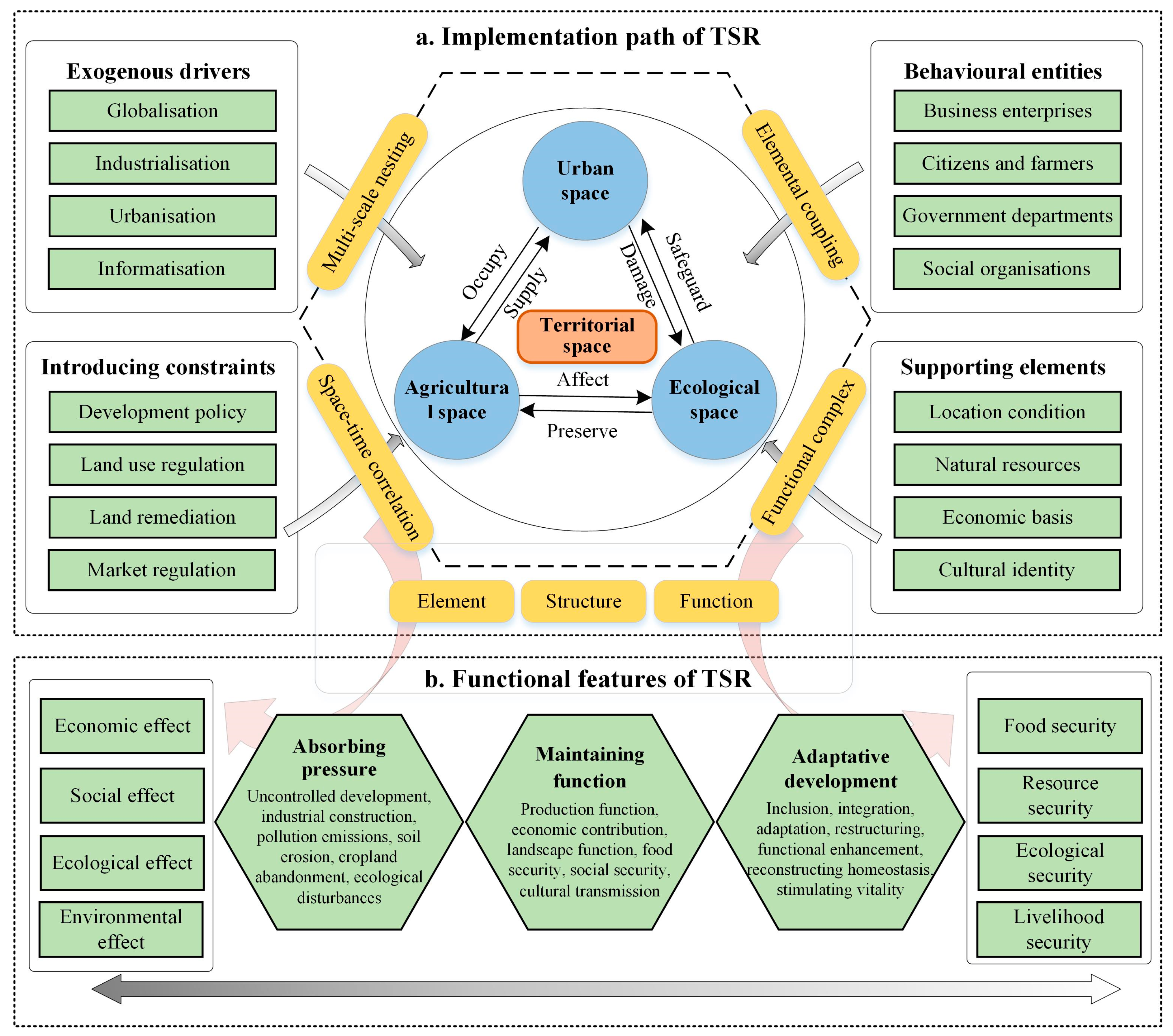
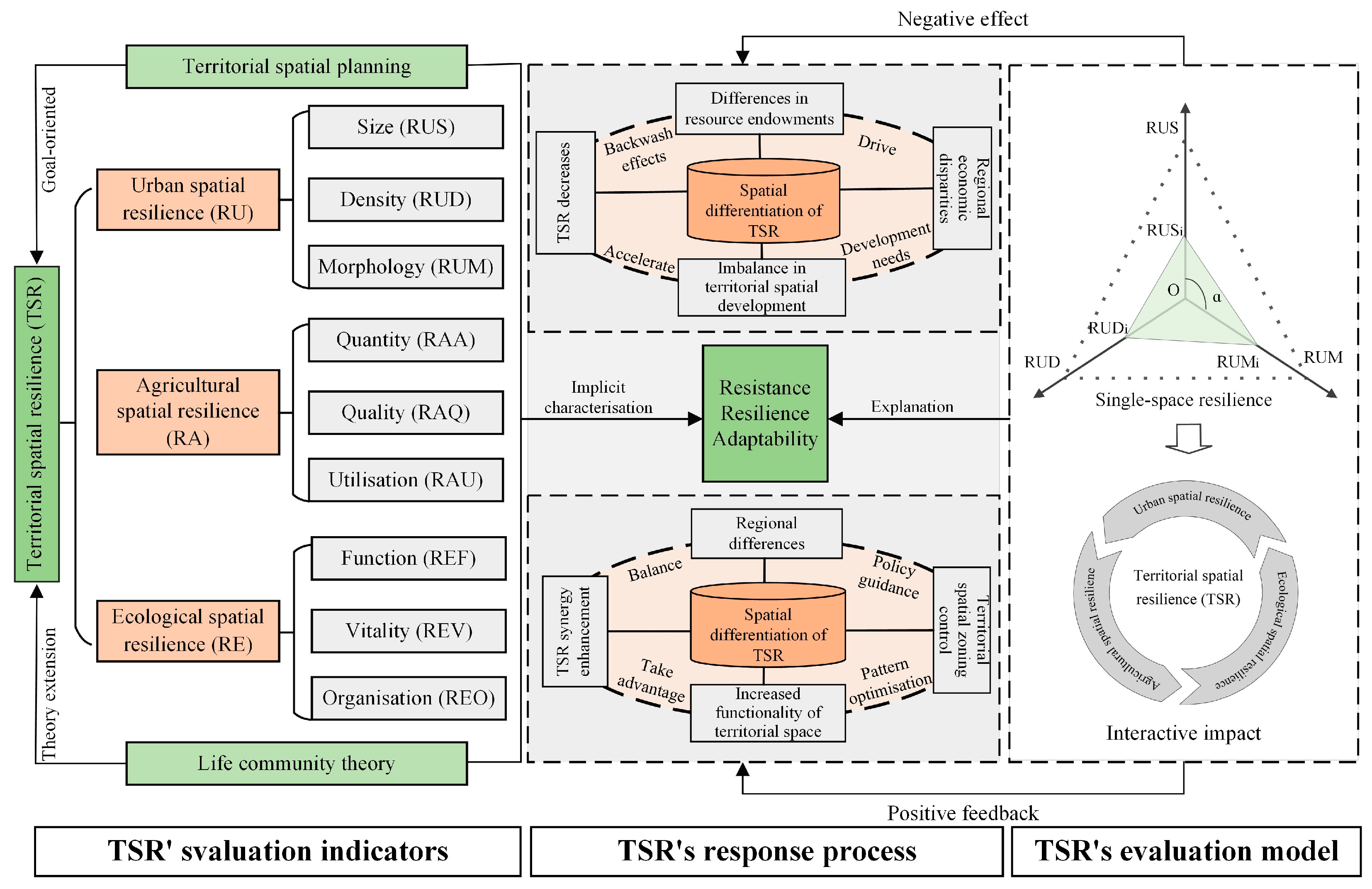
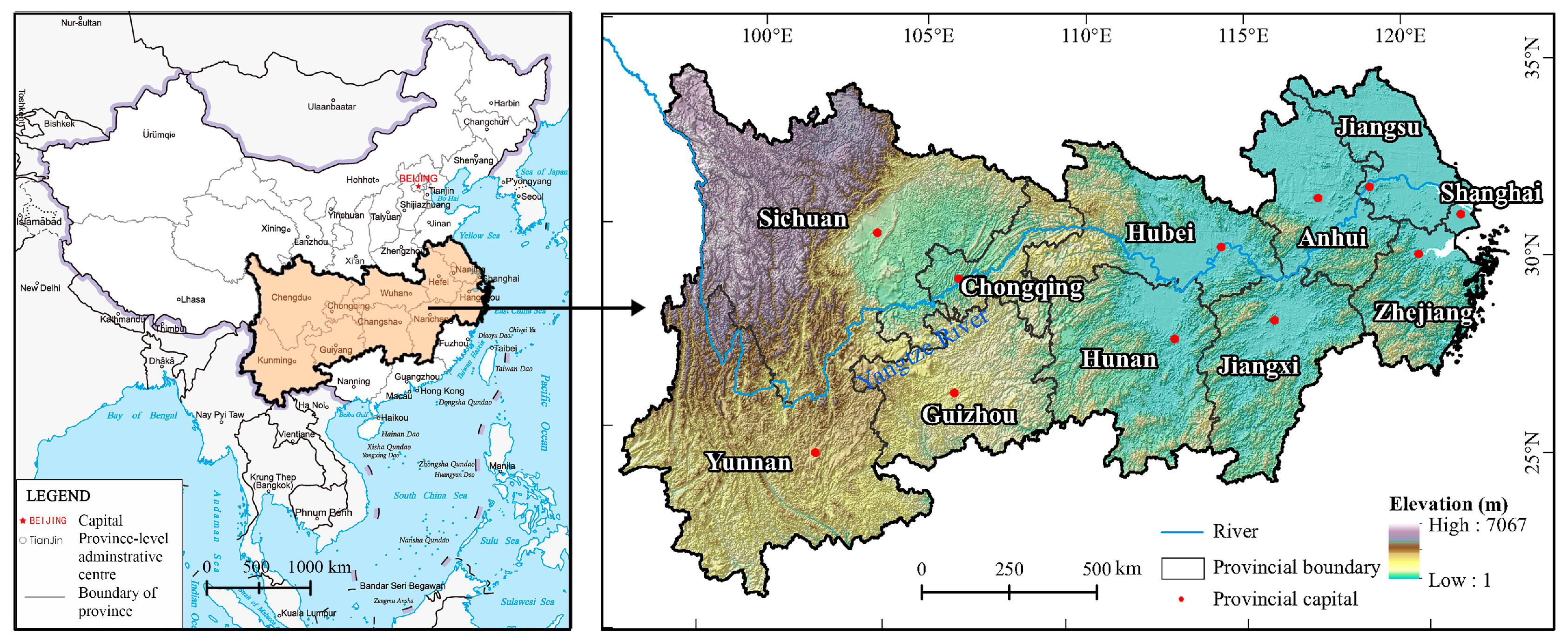


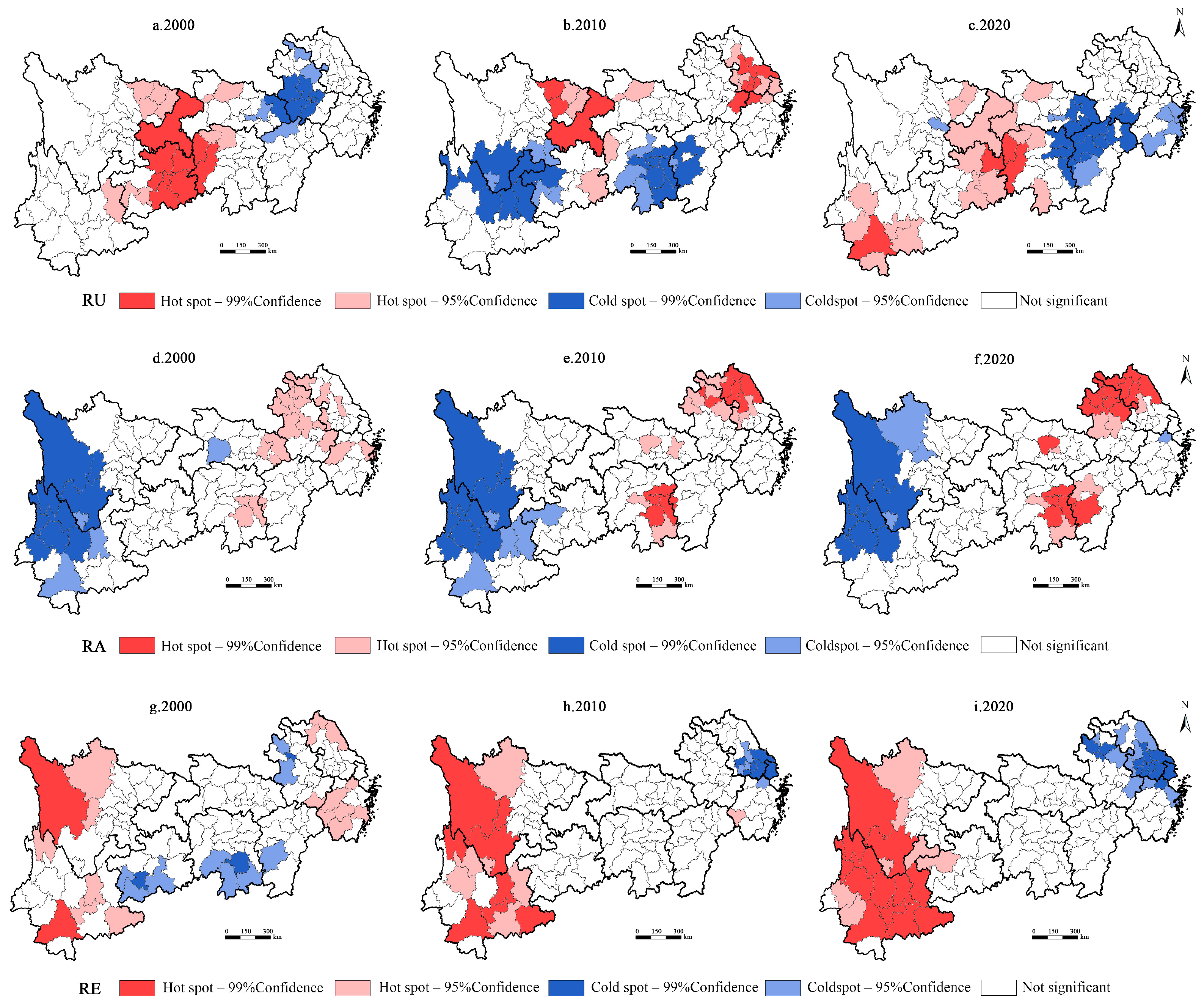


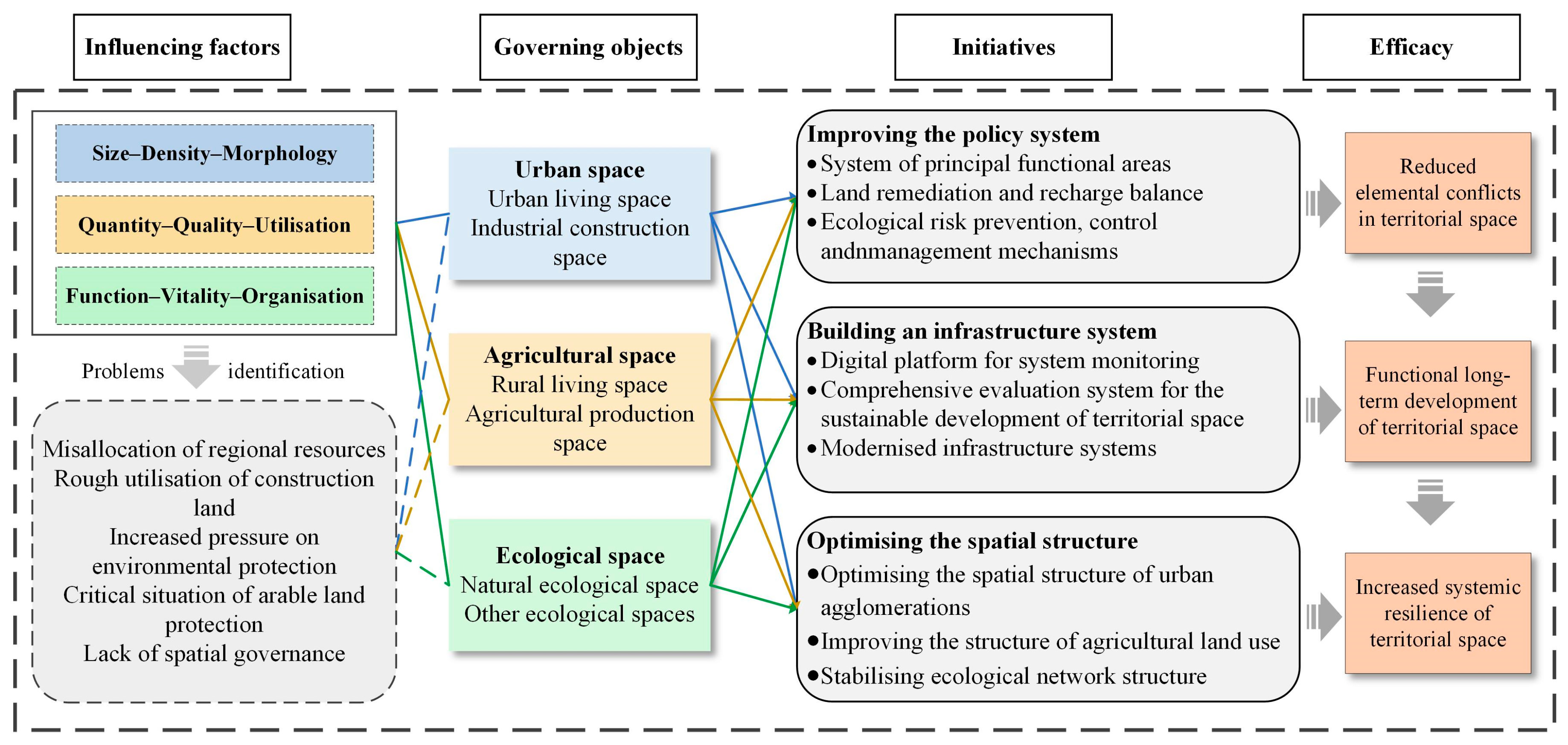
| Name | Index | Formula | Explanation |
|---|---|---|---|
| RU | Size (RUS) | where is the size resilience index of urban space, is the area of land suitable for building and is the area of existing building land. | |
| Density (RUD) | where is the city’s economic density, is the city’s population density, is gross domestic product, and refers to the area and the resident population of the city, respectively. | ||
| Morphology (RUM) | where is the morphological density index of urban space, is the minimum cost distance from source raster to the nearest sink, is the number of source raster in the study area, and is the average distance index value for the source–sink landscape across the YREB. | ||
| RA | Quantity (RAA) | where is cropland pressure index, and are the minimum per capita cropland area and the actual per capita cropland area (hm2/person), respectively, is food self-sufficiency rate (%), is the grain yield per unit area (kg/hm2), is the proportion of area sown to grain to total sown area (%), is the replanting index, and is the per capita food requirement (kg/person). With = 1 as the early warning line, the greater the value of , the greater the pressure on cropland protection and the lower the level of agricultural spatial security. With reference to international food security standards and actual food production, the per capita food requirements for 2000, 2010 and 2020 were set at 400, 420 and 440 kg, respectively. Since more than half of the provinces in the YREB are major food-producing areas, the food self-sufficiency rate is taken to be 100%. | |
| Quality (RAQ) | where is the average arable land suitability, is the total area of agricultural space in the study unit, is the area of image element j in agricultural land in the study area and is the agricultural suitability of image element j in agricultural land. | ||
| Utilisation (RAU) | is the value of agricultural production in the study area and is the area of agricultural land. | ||
| RE | Function (REF) | where is the functional resilience of ecological space, is the ecosystem service value of raster , is the area of raster , ESc is the service coefficient of the ecosystem value for the land use type corresponding to raster and are the spatial neighbourhood coefficients. | |
| Vitality (REV) | where is the near-infrared band reflectance value, and is the red band reflectance value. can reflect the state of vegetation cover, with a range of values from −1 to 1. indicates that the ground cover is water, snow, ice or clouds; indicates that there is vegetation growing on the surface, and the higher the value, the better the grade of vegetation cover. | ||
| Organisation (REO) | where is the organisational resilience of the ecological space, is the Shannon diversity index, is the fractal dimensionality index, is the patch density and is the landscape contagion index. This calculation was run using Fragstats 4.2. |
| Name | RU | RA | RE | ||||||
|---|---|---|---|---|---|---|---|---|---|
| 2000 | 2010 | 2020 | 2000 | 2010 | 2020 | 2000 | 2010 | 2020 | |
| YREB | 0.234 | 0.147 | 0.231 | 0.256 | 0.263 | 0.266 | 0.169 | 0.194 | 0.201 |
Disclaimer/Publisher’s Note: The statements, opinions and data contained in all publications are solely those of the individual author(s) and contributor(s) and not of MDPI and/or the editor(s). MDPI and/or the editor(s) disclaim responsibility for any injury to people or property resulting from any ideas, methods, instructions or products referred to in the content. |
© 2024 by the authors. Licensee MDPI, Basel, Switzerland. This article is an open access article distributed under the terms and conditions of the Creative Commons Attribution (CC BY) license (https://creativecommons.org/licenses/by/4.0/).
Share and Cite
Cui, J.; Jin, H.; Kong, X.; Sun, J.; Peng, Y.; Zhu, Y. Territorial Spatial Resilience Assessment and Its Optimisation Path: A Case Study of the Yangtze River Economic Belt, China. Land 2024, 13, 1395. https://doi.org/10.3390/land13091395
Cui J, Jin H, Kong X, Sun J, Peng Y, Zhu Y. Territorial Spatial Resilience Assessment and Its Optimisation Path: A Case Study of the Yangtze River Economic Belt, China. Land. 2024; 13(9):1395. https://doi.org/10.3390/land13091395
Chicago/Turabian StyleCui, Jiaxing, Han Jin, Xuesong Kong, Jianwei Sun, Yawen Peng, and Yuanyuan Zhu. 2024. "Territorial Spatial Resilience Assessment and Its Optimisation Path: A Case Study of the Yangtze River Economic Belt, China" Land 13, no. 9: 1395. https://doi.org/10.3390/land13091395
APA StyleCui, J., Jin, H., Kong, X., Sun, J., Peng, Y., & Zhu, Y. (2024). Territorial Spatial Resilience Assessment and Its Optimisation Path: A Case Study of the Yangtze River Economic Belt, China. Land, 13(9), 1395. https://doi.org/10.3390/land13091395








